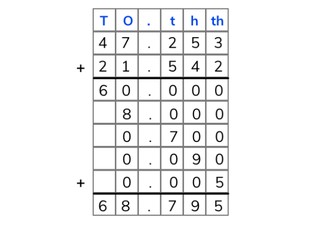
Partial sums addition with decimal numbers to the thousandths place
Students learn to use partial sums to add decimal numbers to the thousandths.



8,000 schools use Gynzy
92,000 teachers use Gynzy
1,600,000 students use Gynzy
General
Students learn to add decimal numbers to the thousandths place using partial sums.
Common core standard(s)
6.NS.B.3
Relevance
It is important to be able to add decimal numbers using partial sums because it means that you can add numbers that are difficult to add in your head.
Introduction
The interactive whiteboard shows a few decimal numbers and some stairs. Ask students to set the decimal numbers in order from smallest to largest on the stairs. Remind students that more decimal numbers after the decimal point does not always mean that a number is larger than say a number with only one decimal number after the decimal point.
Instruction
Explain what the numbers after the decimal point mean and are called. Refresh the names of the tenths, hundredths, and thousandths. Explain to students that when adding using partial sums that you write the numbers one below the other. Then you add from left to right. Tell students that you write the largest number on the top and the smaller number on the bottom. In this case, you start adding at the tens. Add these together. Then you add the ones, the tenths, hundredths, and thousandths. Write all of the partial sums in the boxes and then add the partial sums together to find the total sum which you write at the bottom of the boxes. Show students a problem in which the problem is written in but where they need to write in the partial sums. Ask students to write down the partial sums on a sheet of paper and hold them up so that they can be checked. Next show three problems that students must solve using partial sums where the problems have already been written into the boxes. Then have students complete an entire problem including writing the problems into the boxes. At the end challenge students with a problem which has three addends.
Check that students have understood addition with decimal numbers to 100 using partial sums by asking the following questions/giving the following tasks:
- Why is it useful to be able to add using partial sums?
- Where do. you always start when adding with partial sums?
- Solve the following problems. 43.25.+.21.64 = ? and 54.351 + 31.563 = ?
Guided practice
Students start with problems in which they only need to write the totals to the partial sums, as the math problem and final total are already given. They then are asked to solve the entire problem, and are also asked to write in the math problem and solve.
Closing
Discuss why it is important to be able to add decimal numbers to the thousandths place using partial sums, namely that it allows them to add larger numbers together and solve them easily. Check that students know to start their calculations on the left side. The interactive whiteboard shows two math problems with the numbers 0 to 9 visible. Ask students to create addition problems with decimal numbers to solve as a class.
Teaching tips
Students who have difficulty adding using partial sums can be supported by spending extra time on the decimal place value chart. Make sure that they understand that they are solving each addition problem per place value and then finally adding all of them together for the final total.
The online teaching platform for interactive whiteboards and displays in schools
Save time building lessons
Manage the classroom more efficiently
Increase student engagement
Discover more!
About Gynzy
Gynzy is an online teaching platform for interactive whiteboards and displays in schools.
With a focus on elementary education, Gynzy’s Whiteboard, digital tools, and activities make it easy for teachers to save time building lessons, increase student engagement, and make classroom management more efficient.



